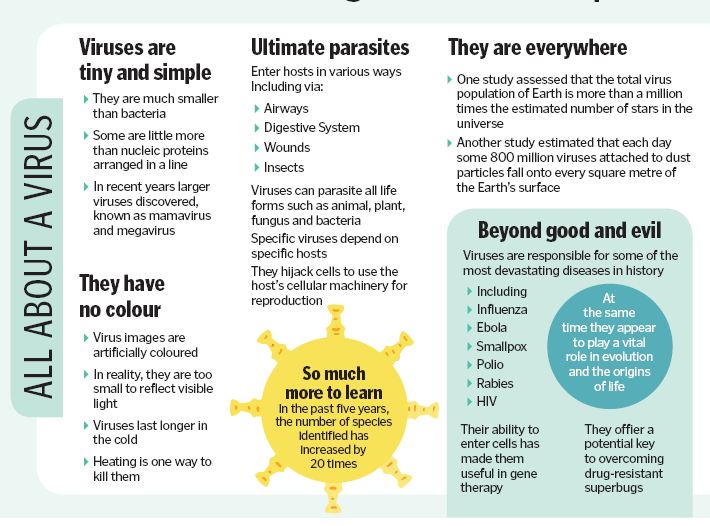Virus–the most abundant organisms on the planet
Viruses are microscopic parasites, generally much smaller than bacteria. They lack the capacity to thrive and reproduce outside of a host body
Updated On - 20 December 2020, 06:11 PM
Predominantly, viruses have a reputation for being the cause of contagion. Widespread events of disease and death have no doubt bolstered such a reputation. The 2014 outbreak of Ebola in West Africa, and the 2009 H1N1/swine flu pandemic (a widespread global outbreak) likely come to mind. While such viruses certainly are wily foes for scientists and medical professionals, others of their ilk have been instrumental as research tools; furthering the understanding of basic cellular processes such as the mechanics of protein synthesis, and of viruses themselves.
Discovery
 With a diameter of 220 nanometers, the measles virus is about 8 times smaller than E.coli bacteria. At 45 nm, the hepatitis virus is about 40 times smaller than E.coli.
With a diameter of 220 nanometers, the measles virus is about 8 times smaller than E.coli bacteria. At 45 nm, the hepatitis virus is about 40 times smaller than E.coli.
For a sense of how small this is, David R. Wessner, a professor of biology at Davidson College, provides an analogy in a 2010 article published in the journal Nature Education: The polio virus, 30 nm across, is about 10,000 times smaller than a grain of salt. Such differences in size between viruses and bacteria provided the critical first clue of the former’s existence.
Toward the end of the 19th century the notion that microorganisms, especially bacteria, could cause disease was well established.
Structure
Viruses teeter on the boundaries of what is considered life. On one hand, they contain the key elements that make up all living organisms: the nucleic acids, DNA or RNA (any given virus can only have one or the other). On the other hand, viruses lack the capacity to independently read and act upon the information contained within these nucleic acids.
New discoveries
Understanding the relationships between viruses began with noting similarities in size and shape, whether viruses contained DNA or RNA, and in which form. With better methods to sequence and compare viral genomes, and with the constant influx of new scientific data, what we know about viruses and their histories is constantly being fine-tuned.

Now you can get handpicked stories from Telangana Today on Telegram everyday. Click the link to subscribe.
Click to follow Telangana Today Facebook page and Twitter .